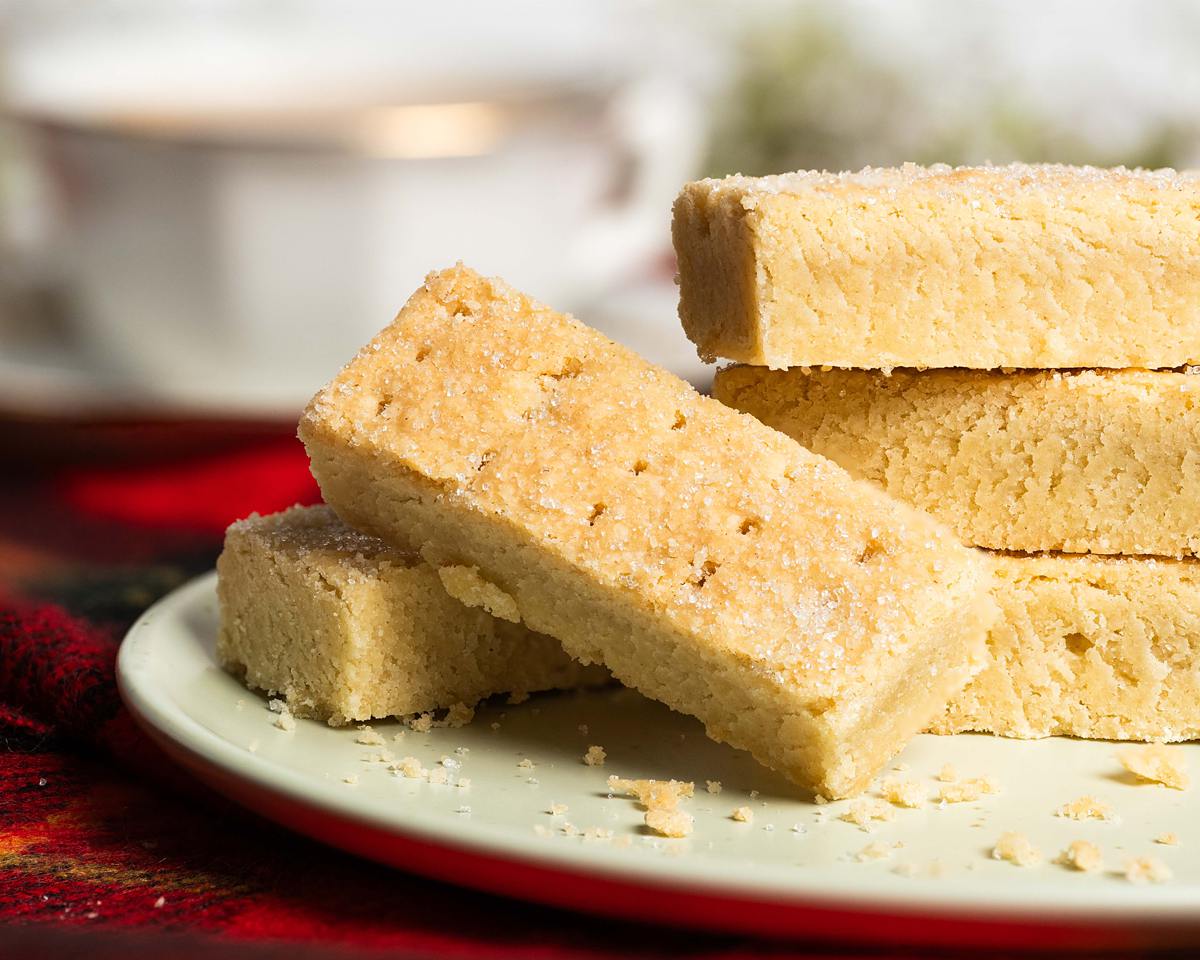This delicious Scottish shortbread recipe is one shared with me by a good friend passed down from her Scottish grandmother. It is hands down the best Scottish shortbread recipe I have ever tried and I am so excited for you to try it too!
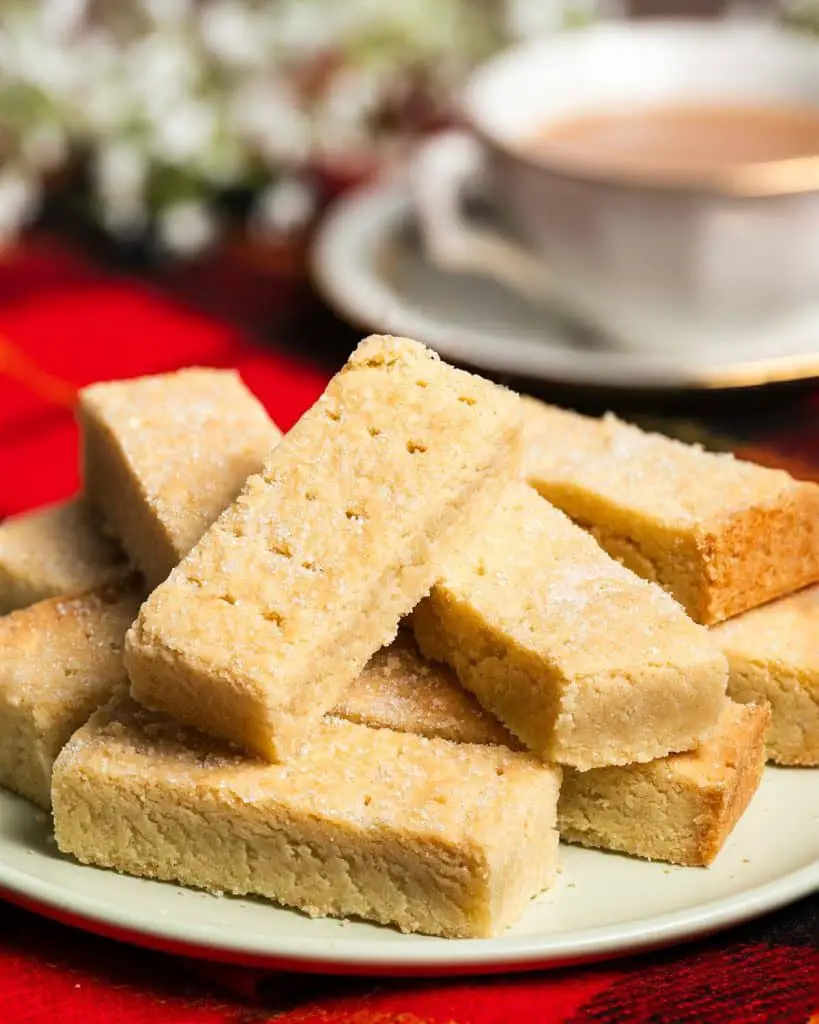
What is shortbread?
Shortbread is a traditional Scottish biscuit usually made from one part sugar, two parts butter and three parts plain flour. It is a really simple recipe, and requires no fancy equipment to make: just a bowl large enough, a tray to bake on and your hands!
Why do they call it shortbread?
The word “short” is used to reflect the crumbly texture of the bake, as opposed to being stretchy or chewy. The “bread” part of the word refers back to when Scottish bakers would call this a “bread” rather than a “biscuit”. This was so they could avoid taxes on biscuits, which were considered a luxury at the time. And so the name “shortbread” came into being!
What is the difference between English shortbread and Scottish shortbread?
There is none! Shortbread is a traditional Scottish bake, and has been adopted and used in England and all around the world by many!
Having said that, there are many recipes out there that call themselves shortbread that are similar in result to the traditional recipe I am sharing here. However, they will include additional ingredients such as leavening agents and sometimes even eggs. These additions will change the texture to being more like a sugar cookie than a crumbly shortbread.
What is the difference between butter cookies and shortbread?
As with the difference between the meaning of biscuits in different parts of the world, so is there with shortbread, butter cookies and sugar cookies! Here is my definition of them:
Shortbread: a traditional Scottish bake, made with basic ingredients of flour, butter and sugar using the proportions of 3-2-1. That is, three parts flour, two parts butter and one part sugar combined make a basic shortbread recipe. Please note that traditional shortbread is a totally egg free bake.
Sugar cookies: this is similar to shortbread but with the addition of eggs and normally a little more sugar in the recipe. In the UK, we would call these biscuits. This dough can be rolled, cut and shaped more easily, and can make biscuits or cookies that have a firmer texture and more of a snap than cookies.
Butter cookies: these are firm and brittle when baked, in other words they snap and do not bend. But the key thing with butter cookies is that the dough is much softer and is piped rather than rolled and stamped out like the other two. Think Viennese whirls or other biscuits that are piped into shape, then chilled until firm before being baked.
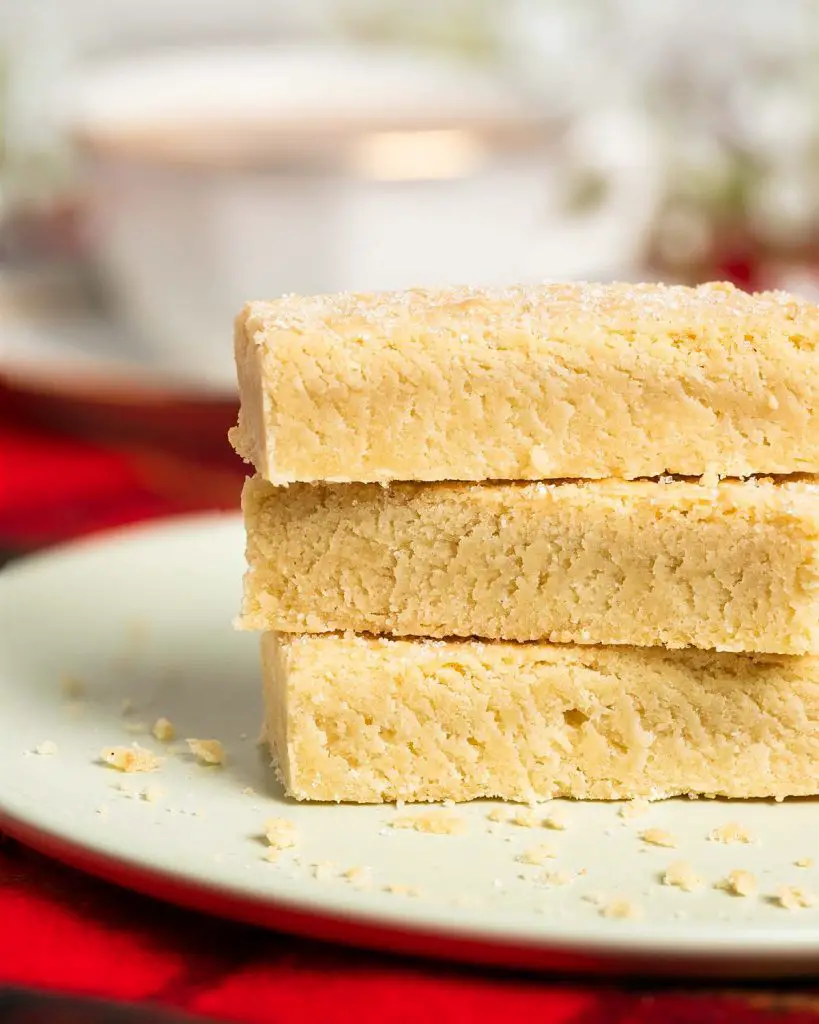
What’s the ingredients for shortbread?
- Unsalted butter: a key ingredient, make sure to always use block butter when making Scottish shortbread cookies. Butter really important here, as using margarine or any other fat will not give you the same beautiful flavour or texture you want from a melt in your mouth Scottish shortbread recipe.
- Sugar: caster sugar is used in the dough for sweetness. Using white sugar is important here, and not a brown sugar. A brown sugar will not only change the colour of the butter shortbread cookies, but it would also add extra moisture to the bake, affecting the final result of the cookies. I also used a little granulated sugar for sprinkling over the top of the butter shortbread once baked.
- Flour: plain or all purpose flour is used to make this classic Scottish shortbread. Avoid self raising flour, and use a white flour to help keep the pale colour of the finished bake.
- Salt: just a little bit, to enhance the simple flavour of this Scottish shortbread recipe. Omit adding salt if you use salted butter.
What equipment do I need to make Scottish shortbread?
- Parchment/baking paper: to line the tin before baking the all butter shortbread in it.
- Baking tin*: you will need an 8”x 8” pan to make the 4 ingredient shortbread cookies in.
- Digital kitchen scales*: I provide all my measurements in cups too, however I would encourage all bakers to weigh out ingredients when baking. A set of digital kitchen scales is so useful and totally an essential baking tool for me.
- Measuring spoons*: a set of measuring spoons is essential for any baker. This is because these are more accurate than using everyday teaspoons and tablespoons, which can vary greatly in size.
- Mixing bowl*: used to make the basic shortbread recipe in.
- Handheld electric mixer*: this old fashioned shortbread recipe can absolutely be made entirely by hand, but if you wanted a little extra help, this is the tool for the job!
- Spatula*: for the final stages of pressing the best shortbread cookie dough together, but also useful to help press it into the tin before baking.
How to make Scottish shortbread
This homemade Scottish shortbread is so simple to make! Combine the butter and sugar until smooth, then mix in the flour and salt before pressing in the tin, pricking and baking. That is literally it!
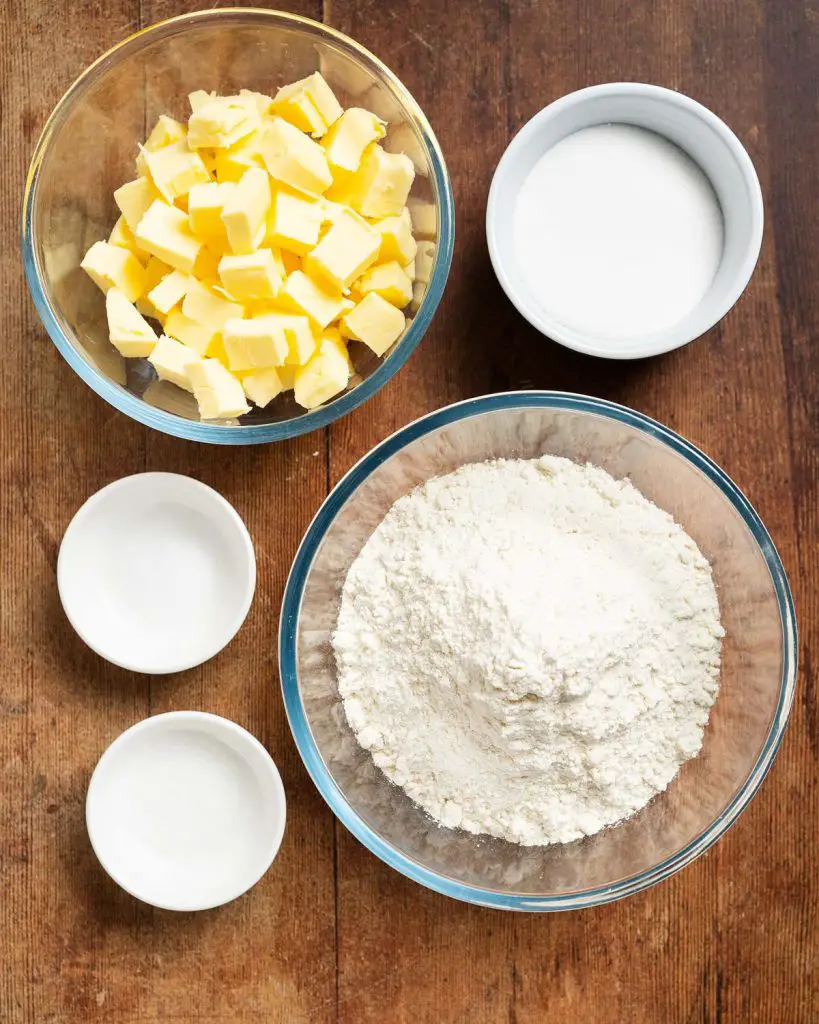
Step 1: Preheat the oven to 180C/350F. Line an 8″ square tin with parchment paper, then set aside whilst making the shortbread.
Step 2: In a large bowl, tip in the butter and sugar. Mix together until completely combined, but not pale and fluffy. Sift in the flour and salt and push together to combine until it comes together into a soft and slightly crumbly dough.
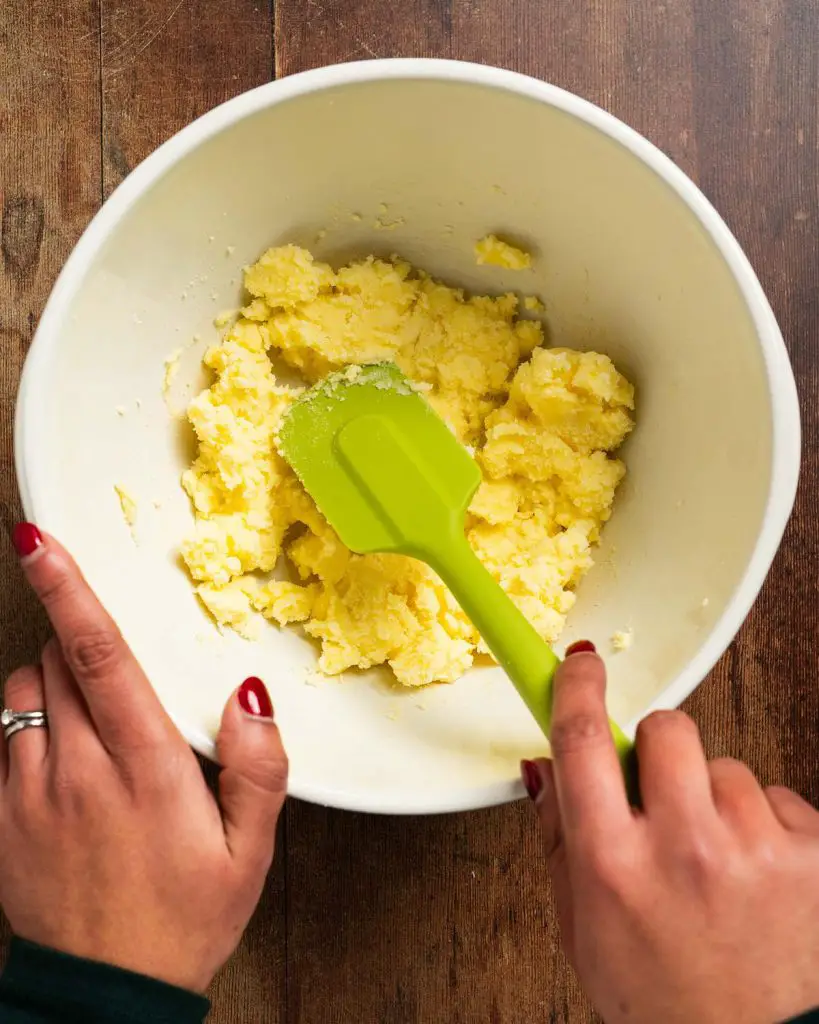
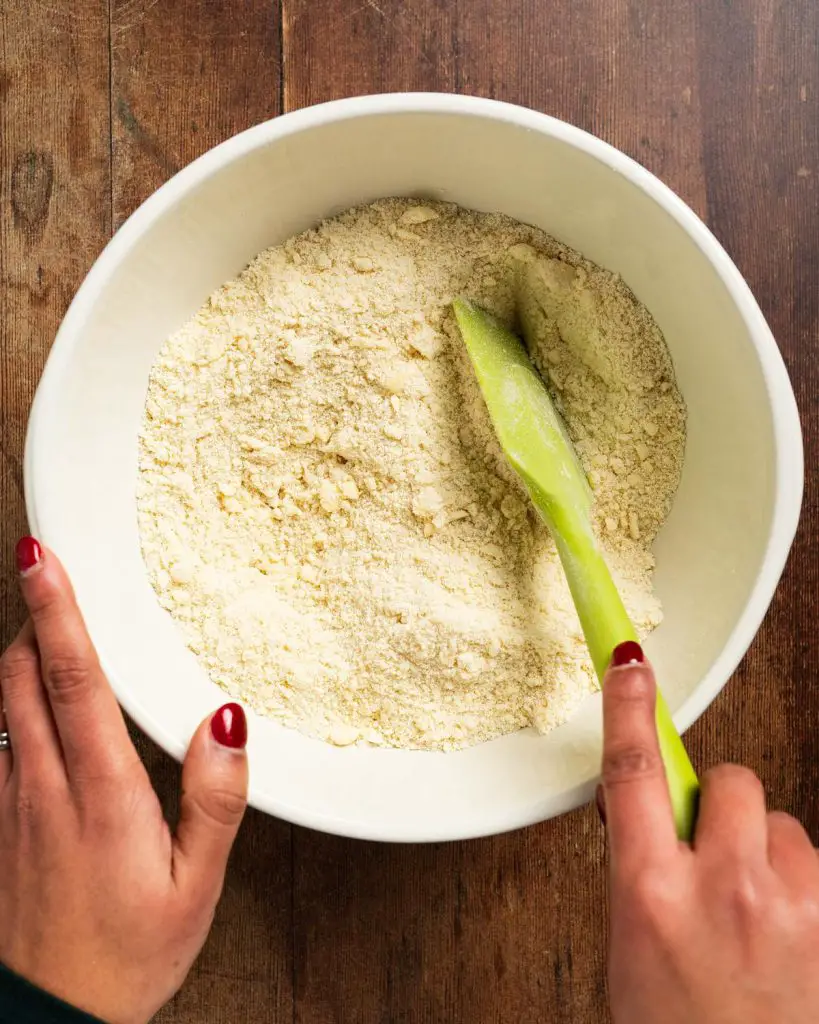
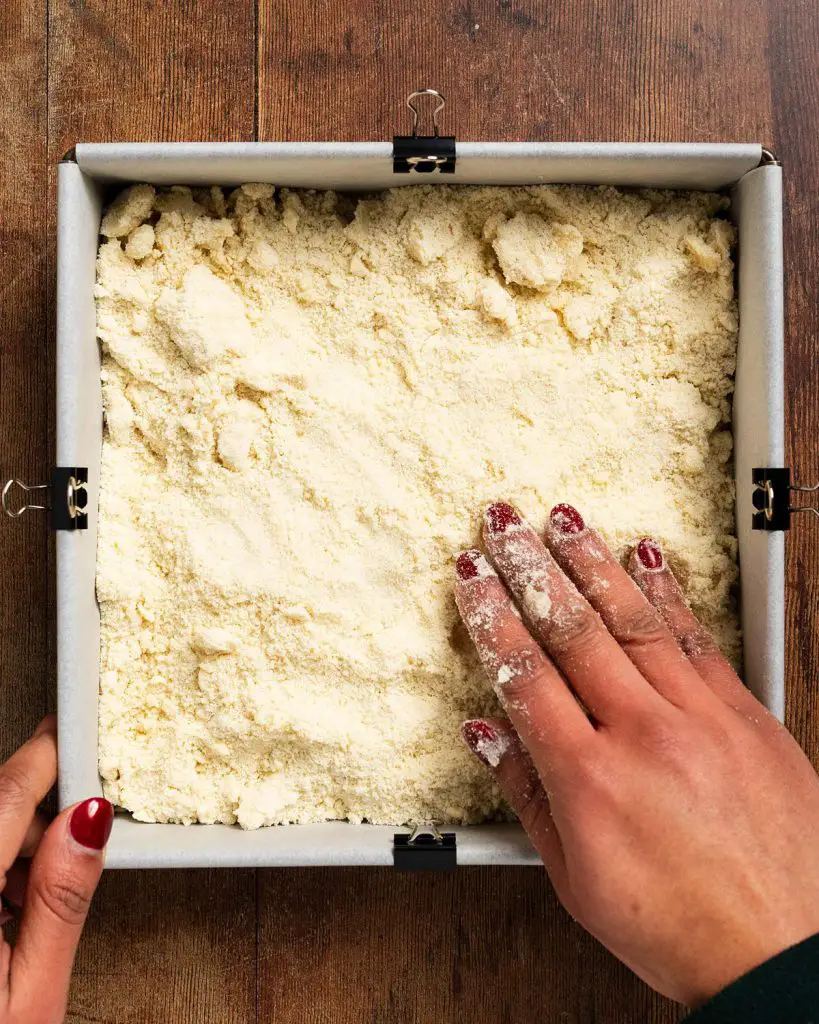
Step 3: Tip the dough into the prepared tin and press down into an even layer. Cut the dough into fingers then use a fork to prick the dough, pushing the fork about halfway down each slice.
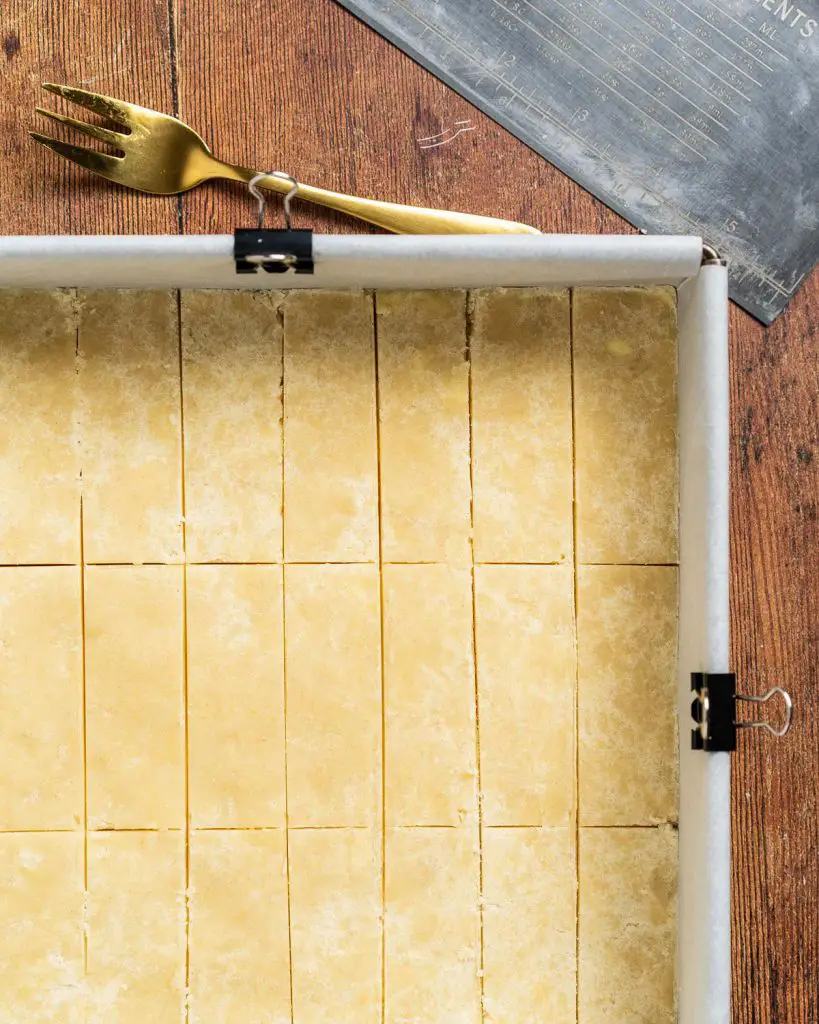
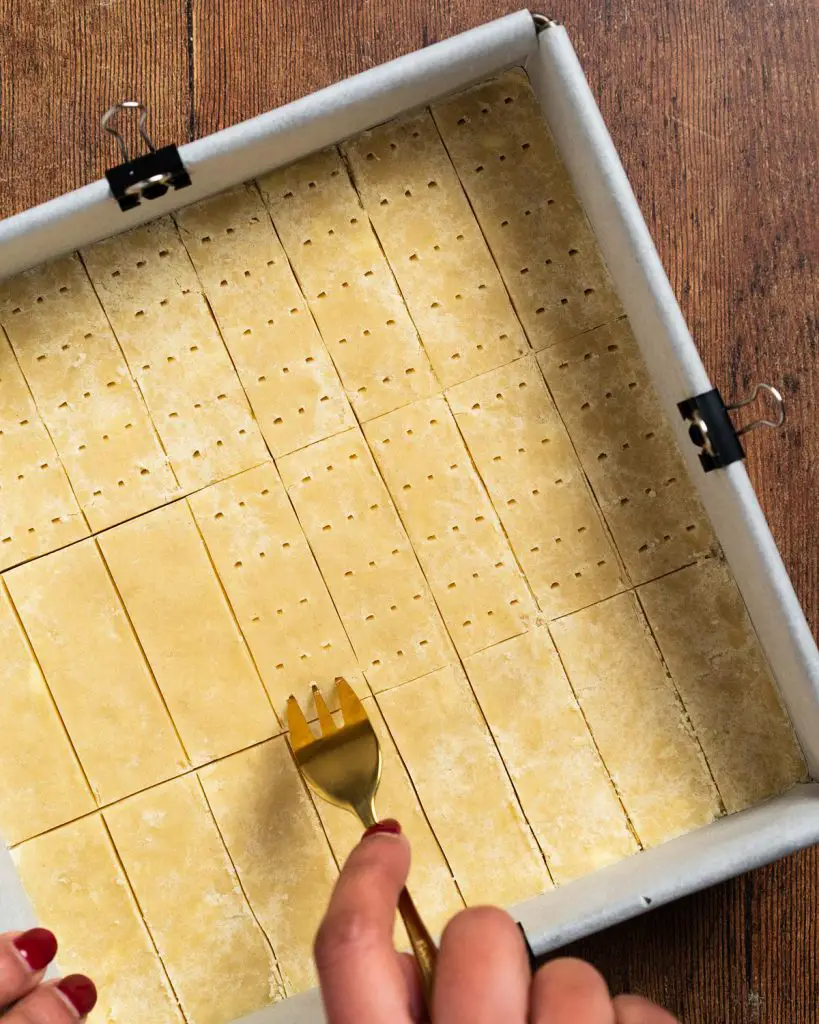
Step 4: Bake in the preheated oven for 25-30 minutes until the top looks dry and the edges are just starting to go golden. Remove from the oven and refresh the cuts before sprinkling with granulated sugar. Leave to cool in the tin before breaking out to share. Enjoy!
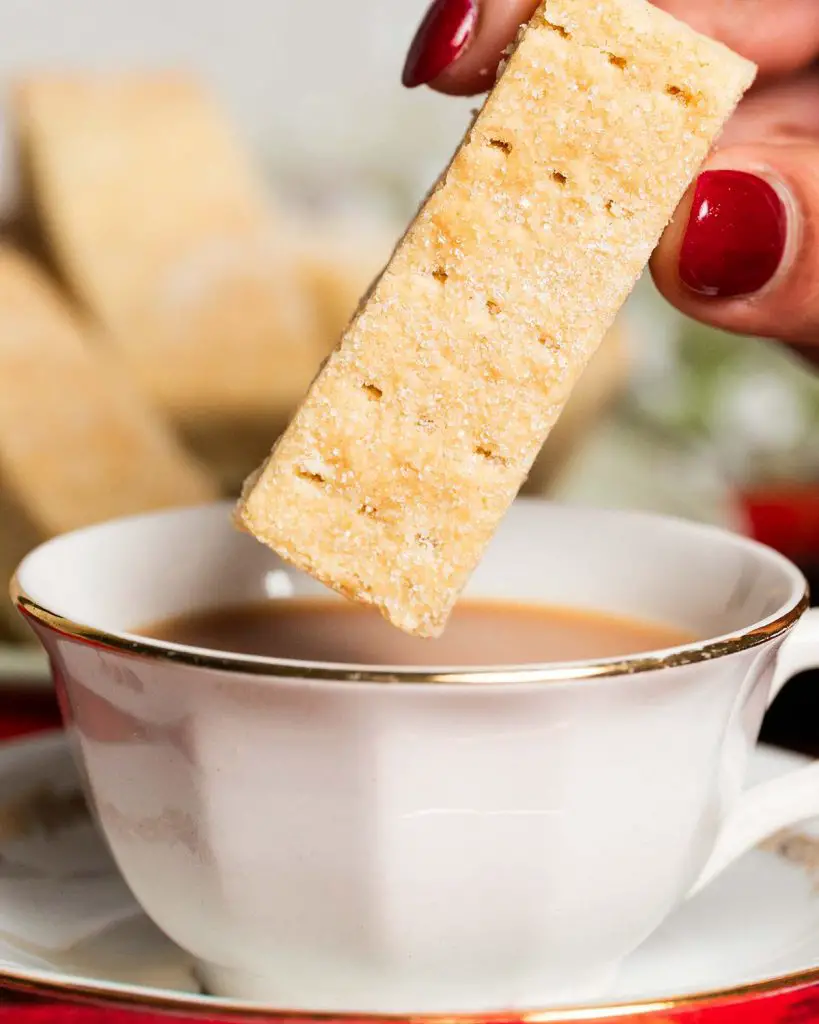
Shortbread tips
Below I share all the top tips I can think of, including potential problems, to help you make the best shortbread biscuits.
What makes a good shortbread?
There are two basic parts to ensure you make the best shortbread cookies every time. One is using really good ingredients, most especially a good quality butter as this will make a huge difference to the finished bake. The other is having a reliable and accurate recipe alongside consistent measurements. With this in mind, I would always recommend measuring out ingredients using a weighing scale when making this best recipe for shortbread. Since the ingredients used are minimal, the quality and accuracy of measuring them is completely what will make or break the results!
Why is my Scottish shortbread dough too crumbly? How can I fix it?
If you find the recipe results in a dry dough, no need to fret! Simply add a little additional butter (half a teaspoon at a time) to the Scottish shortbread biscuits dough and squeeze to bring it together. Then continue as per the recipe.
Should shortbread dough be kneaded or not?
Shortbread dough, like shortcrust pastry, should not be kneaded when bringing it together. Instead, squeeze to bring together into one larger dough, then roll and cut or press out immediately before leaving to chill or baking. Kneading the all butter Scottish shortbread before pressing into the tin is more likely to give you a tough biscuit rather than the beautiful texture we want in these old fashioned shortbread Scottish.
Why do you prick shortbread?
Baking this traditional Scottish shortbread is a lot like baking pastry: you prick pastry too before baking. This ensures the moisture in the dough has a means of escape, allowing the dough to bake evenly and not bubble up in places. It also gives the classic pricked finishing touch for which Scottish shortbread is known.
Different ways to shape Scottish shortbread
I have chosen to make my shortbread in a tin for the classic fingers. However, if you wish, you could also easily shape this best shortbread biscuit into a round dough shape, pinching around the edges. Cut it into wedges and prick before baking for a different finish. As a special alternative, you could also push the mixture into moulds to make individual Christmas shortbread biscuits too.

How to know when shortbread is baked
When shortbread is done baking, it will go from looking a little wet on top when baking to looking dry and pale. The edges of the buttery shortbread cookies will be just beginning to turn golden. Additionally, when lightly pressed the shortbread will still be soft. It firms up as it cools, to a wonderful buttery crumbly biscuit.
Why does shortbread spread when baked?
Traditional shortbread recipes use a lot of butter. This is fabulous as it gives the shortbread that wonderful, melt in your mouth texture everyone loves about this unique bake. However, the downside is that butter does melt when exposed to high temperatures, and so can result in flatter, more spread out shortbread cookies. To combat this, in this recipe I have chosen to bake it in a tin. This ensures the dough does not spread during baking, resulting in the best shortbread recipe you have ever tried.
How long does Scottish shortbread last?
This best buttery shortbread recipe keeps well for weeks, but I would recommend enjoying it within a week of baking. Store in an airtight container in a cool, dry place. If you wish to keep longer than a week, I would recommend freezing it.
What to serve with Scottish shortbread
Shortbread would normally be served as an edible accompaniment to a cup of tea, normally mid afternoon. Think more of an every day afternoon tea, as a little “pick me up” to keep you going until your evening meal!
Shortbread pairs perfectly with two beverages: tea and whisky
Although most Scottish shortbread recipes would position shortbread as being perfect to serve with tea, it actually works wonderfully well with a dram of whisky too! Pairing two traditional Scottish creations together could not be better! I must say, I am not much of a whisky drinker myself, so for me it has to be shortbread and tea all the way!
Can I freeze this Scottish shortbread?
Yes! This best shortbread recipe ever freezes brilliantly, either before or after baking, depending on your preference!
To freeze the shortbread dough, wrap it tightly in cling film (cling wrap) and place it in a freezer bag or freezer safe container. The dough can be frozen for up to three months. To bake, thaw the dough in the fridge overnight or on the worktop for a few hours before shaping and baking as per the recipe.
To freeze baked shortbread, allow the biscuits to cool completely. Place the baked shortbread in a freezer safe air tight container. If you are stacking the shortbreads in your container, I would recommend putting a layer of parchment paper between each layer of the eggless shortbread cookies. The shortbread will freeze well for up to three months. To thaw, simply leave at room temperature on a cooling rack for a few hours.
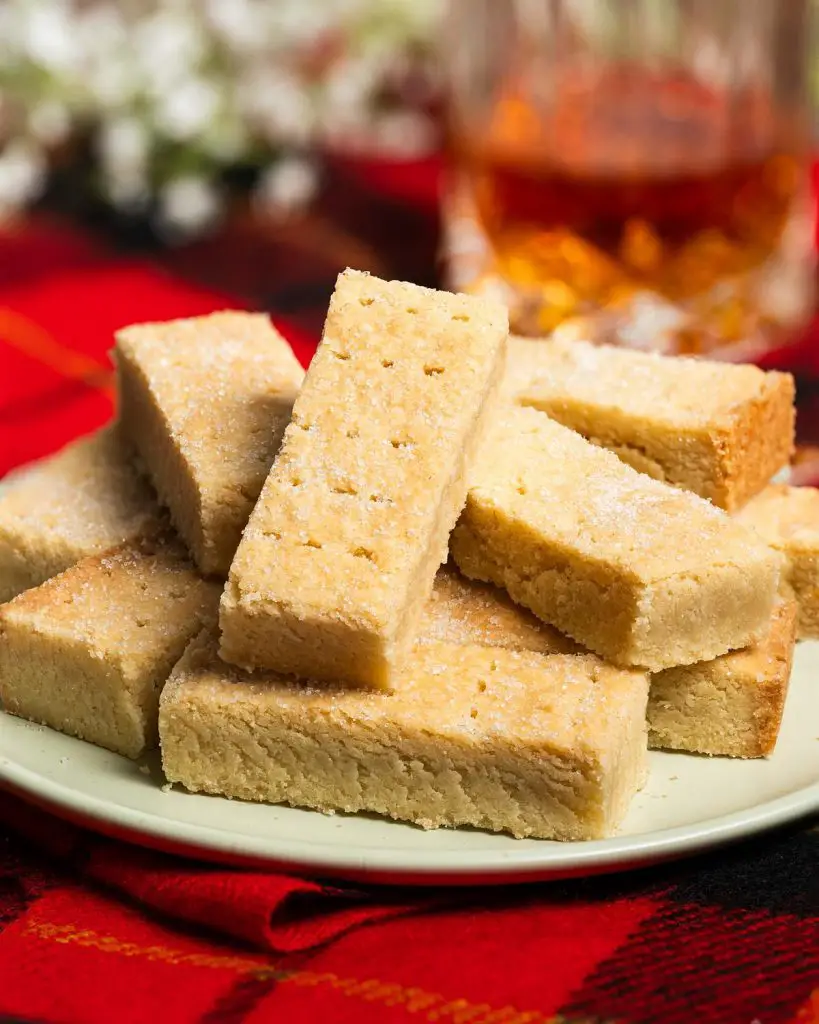
Quick tips for making the best shortbread ever recipe
- Make sure to use the best quality ingredients, especially the butter, you can find and afford. The butter, in particular, really makes a huge different to the final resulting bake.
- Use butter that is softened and at room temperature. This is so that the butter and sugar combine easily without needing to be beaten to much. Over beating of the butter in this recipe will affect the final baked results, not giving the texture you want.
- Sifting the flour and salt into the butter mixture makes it easier to incorporate the ingredients, hence I would highly recommend it.
- If you prefer to use salted butter when making this shortbread, omit the additional salt in the recipe. Please keep in mind using salted butter gives less control of the amount of salt in the bake, so you may find it ends up saltier than you would like.
- The dough should come together in clumps when squeezed before pressing into the tin. If it does not, add a little extra butter to achieve the correct consistency.
- Cutting the dough once it has been pressed into the tin will make it easier to cut once baked.
- Pricking the shortbread before baking allows moisture to escape from the dough during baking. It also prevents the dough from bubbling up in places during baking, resulting in an even shortbread.
- As soon as the shortbread comes out of the oven, recut along the cuts done before baking to ensure the shortbread does not seal together.
- Sprinkle a little granulated sugar over the top of the baked shortbread for a lovely finishing touch to your Scottish shortbread.
Troubleshooting
If you have any other questions about this best shortbread recipes, please leave me a comment below, I would love to help. And if you do make this recipe for Scottish shortbread, please do consider leaving a rating and review below. I would really appreciate your feedback to grow my website and it really helps others looking for a similar recipe too. Additionally, you could also post a picture on Instagram and tag me when you share it with the world. You already know I would love to see!
More shortbread recipes from my blog for you to enjoy
Lemon shortbread cookies: The best lemon shortbread cookies recipe! Wonderfully lemony, melt in your mouth shortbread cookies, topped with a zingy lemon glaze. Trust me, this one is the ultimate recipe for lemon shortbread cookies, everyone loves them!
Rose and pistachio shortbread cookies: My rose and pistachio shortbread cookies are buttery and delicious. They are packed with all the beautiful flavours of delicate rose, earthy pistachio and fragrant cardamom. Yum!
Cranberry orange shortbread cookies: A buttery shortbread packed with beautiful fresh orange flavour and pops of cranberries. These Christmas orange shortbread cookies always go down a treat!
Chocolate orange shortbread: My beautiful buttery shortbread bursting with vibrant orange zest and rich dark chocolate is so good, you will struggle to stop at just one!
Happy baking, my friends! x

Recommended equipment I used *
| Baking tin | Digital kitchen scales |
| Measuring spoons | Mixing bowl |
| Handheld electric mixer | Spatula |

